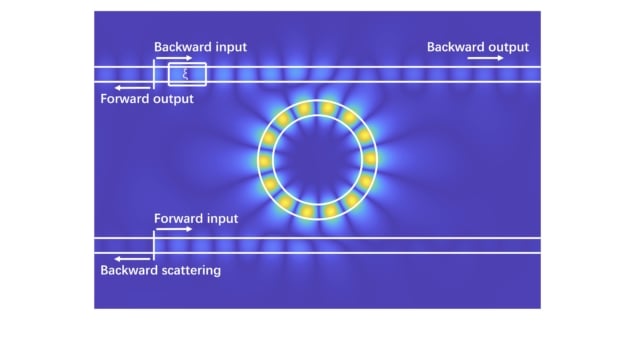
A new method for making devices that act like a “one-way street” for light has been developed by researchers in China and Japan. The technique, which breaks the limit of dynamic reciprocity in nonlinear optical systems, could be important for applications in photon-based information processing.
Reciprocity – or more precisely, Lorentz reciprocity – is a fundamental principle of optics that decrees that electromagnetic signals must propagate freely in both directions through an optical fibre or electrical circuit. A microwave pulse, for example, can travel in either direction along a waveguide and a light signal can move both ways along an optical fibre. This two-way traffic can cause problems such as backscattering, which reduces the strength of the transmitted signal.
Some technologies for avoiding reciprocity already exist. Isolators in radar microwave transmitters, for example, get around the reciprocity rule by using a large external magnetic field to isolate the waves travelling in the reflected (backwards) direction. However, the devices employed to achieve this, called Faraday rotors, rely on the magneto-optical effect, and thus require strong, heavy magnets. Such magnets are incompatible with photonic chips, and they also considerably increase the power consumption of circuits. While nonmagnetic isolators have been developed, their performance has been poor so far.
Kerr nonlinearity
An alternative way to break Lorentz reciprocity is to use optical nonlinear effects such as Kerr nonlinearity, which is observed when high-intensity light propagates through a medium. The simplest manifestation of this effect can be described as a change in the refractive index of the medium that is proportional to the intensity of the light. In contrast to magneto-optical effects, nonreciprocal devices using such optical nonlinearity are compatible with photonic chip integration, explains Keyu Xia of Nanjing University, Nanjing, who led the new research effort together with Franco Nori of the RIKEN Quantum Computing Center. Kerr nonlinearity exists in many optical materials, including silicon, which is widely employed in photonics.
When designing nonlinear isolators and circulators, scientists are accustomed to taking into account the Kerr nonlinearity of materials individually in a circuit or waveguide, Xia adds. “This leads to ‘dynamic reciprocity’, which causes another problem: a nonlinear nonreciprocity device cannot block the backscattering when the forward and backward-propagating light fields enter the device at the same time, so imposing a fundamental constraint on Kerr-mode nonlinear devices used as optical isolators,” he explains.
Xia and colleagues have now shown that a nonlinear optical material, such as silicon, can be used to overcome this problem and make on-chip devices (such as optical isolators and circulators) when two separate nonlinearity effects are considered. The first, known as the self-Kerr effect, is an optical nonlinearity effect that produces a phase shift proportional to the square of the number of photons in the field. The second, termed cross-Kerr nonlinearity, is a coherent effect that dramatically changes the optical response of the medium to light at selected frequencies.
Achieving dynamic nonreciprocity
The new technique works because in most optical nonlinear materials, the self- and cross-Kerr nonlinearities have differing strengths. When the forward- and backward-propagating light fields enter a device such as a micro-ring resonator (made from a silicon-based nonlinear material) at the same time, the modulation coming from the self- and cross-Kerr nonlinearities can therefore cause different resonance frequencies for the forward- and backward-circulating modes. These are normally denoted as the clockwise and counter-clockwise modes. “We made use of this chirality to achieve dynamic nonreciprocity in a passive system consisting a micro-ring resonator, two waveguides and an absorber,” Xia explains.

Sound waves break light transmission reciprocity
“Our proposed method bypasses the fundamental constraint of dynamic reciprocity imposed on nonlinear optics,” he tells Physics World. “The same concept has been demonstrated experimentally by another group at Stanford University for an on-chip optical isolator. Our work, published in Chinese Physics Letters, opens a door for realizing on-chip optical isolators and circulators, and thus will boost the integration scale and function of photonic chips.”
The researchers are now testing their integrated nonreciprocal devices in their laboratory. The applied micro-ring resonator in this method severely limits the available nonreciprocal bandwidth to a very narrow scale, of about hundreds of MHz, so they plan to improve this and reduce so-called insertion losses by using only Kerr-nonlinear optical waveguides. “Such a new design would allow many important and practical applications of on-chip nonlinear isolators and circulators because it can process photonic information faster and with lower light loss,” Xia says.
